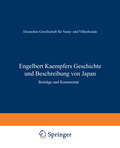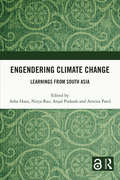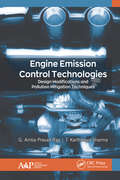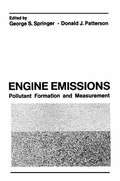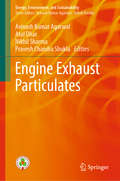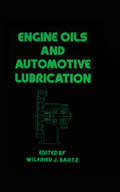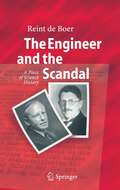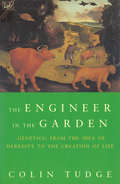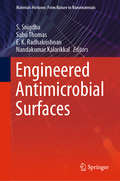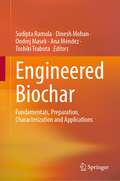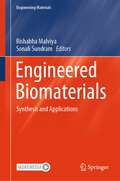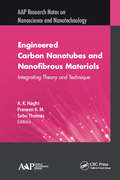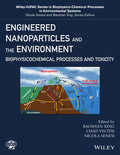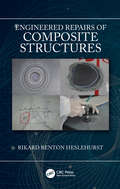- Table View
- List View
Engaging with Contemporary Challenges through Science Education Research: Selected papers from the ESERA 2019 Conference (Contributions from Science Education Research #9)
by Tamer G. Amin Olivia Levrini Mariana Levin Giulia Tasquier Laura BranchettiThis book starts with the premise that beauty can be an engine of transformation and authentic engagement in an increasingly complex world. It presents an organized picture of highlights from the 13th European Science Education Research Association Conference, ESERA 2019, held in Bologna, Italy. The collection includes contributions that discuss contemporary issues such as climate change, multiculturalism, and the flourishing of new interdisciplinary areas of investigation, including the application of cognitive neuroscience, artificial intelligence, and digital humanities to science education research. It also highlights learners’ difficulties engaging with socio-scientific issues in a digital and post-truth era. The volume demonstrates that deepening our understanding is the preferred way to address these challenges and that science education has a key role to play in this effort. In particular, the book advances the argument that the deep and novel character of these challenges requires a collective search for new narratives and languages, an expanding knowledge base and new theoretical perspectives and methods of research. The book provides a contemporary picture of science education research and looks to the theoretical and practical societal challenges of the future.
Engelbert Kaempfers Geschichte und Beschreibung von Japan: Beiträge und Kommentar
by Johann C. Scheuchzer Peter Kapitza Hans Hüls Tadashi ImaiEngendering Climate Change: Learnings from South Asia
by Asha Hans Nitya Rao Anjal Prakash Amrita PatelThis book focuses on the gendered experiences of environmental change across different geographies and social contexts in South Asia and on diverse strategies of adapting to climate variability. The book analyzes how changes in rainfall patterns, floods, droughts, heatwaves and landslides affect those who are directly dependent on the agrarian economy. It examines the socio-economic pressures, including the increase in women’s work burdens both in production and reproduction on gender relations. It also examines coping mechanisms such as male migration and the formation of women’s collectives which create space for agency and change in rigid social relations. The volume looks at perspectives from India, Pakistan, Bangladesh and Nepal to present the nuances of gender relations across borders along with similarities and differences across geographical,socio-cultural and policy contexts. This book will be of interest to researchers and students of sociology, development, gender, economics, environmental studies and South Asian studies. It will also be useful for policymakers, NGOs and think tanks working in the areas of gender, climate change and development.
Engendering Climate Change: Learnings from South Asia
by Asha Hans Nitya Rao Anjal Prakash Amrita Amrita PatelThis book focuses on the gendered experiences of environmental change across different geographies and social contexts in South Asia and on diverse strategies of adapting to climate variability. The book analyzes how changes in rainfall patterns, floods, droughts, heatwaves and landslides affect those who are directly dependent on the agrarian economy. It examines the socio-economic pressures, including the increase in women’s work burdens both in production and reproduction on gender relations. It also examines coping mechanisms such as male migration and the formation of women’s collectives which create space for agency and change in rigid social relations. The volume looks at perspectives from India, Pakistan, Bangladesh and Nepal to present the nuances of gender relations across borders along with similarities and differences across geographical,socio-cultural and policy contexts. This book will be of interest to researchers and students of sociology, development, gender, economics, environmental studies and South Asian studies. It will also be useful for policymakers, NGOs and think tanks working in the areas of gender, climate change and development.
Engine Emission Control Technologies: Design Modifications and Pollution Mitigation Techniques
by G. Amba Prasad Rao T. Karthikeya SharmaThis new volume covers the important issues related to environmental emissions from SI and CI engines as well as their formation and various pollution mitigation techniques. The book addresses aspects of improvements in engine modification, such as design modifications for enhanced performance, both with conventional fuels as well as with new and alternative fuels. It also explores some new combustion concepts that will help to pave the way for complying with new emission concepts.Alternative fuels are addressed in this volume to help mitigate harmful emissions, and alternative power sources for automobiles are also discussed briefly to cover the switch over from fueled engines to electrics, including battery-powered electric vehicles and fuel cells. The authors explain the different technologies available to date to overcome the limitations of conventional prime movers (fueled by both fossil fuels and alternative fuels).Topics examined include:• Engine modifications needed to limit harmful emissions• The use of engine after-treatment devices to contain emissions• The development of new combustion concepts• Adoption of alternative fuels in existing engines• Switching over to electrics—advantages and limitations• Specifications of highly marketed automobiles• Emission measurement methods
Engine Emission Control Technologies: Design Modifications and Pollution Mitigation Techniques
by G. Amba Prasad Rao T. Karthikeya SharmaThis new volume covers the important issues related to environmental emissions from SI and CI engines as well as their formation and various pollution mitigation techniques. The book addresses aspects of improvements in engine modification, such as design modifications for enhanced performance, both with conventional fuels as well as with new and alternative fuels. It also explores some new combustion concepts that will help to pave the way for complying with new emission concepts.Alternative fuels are addressed in this volume to help mitigate harmful emissions, and alternative power sources for automobiles are also discussed briefly to cover the switch over from fueled engines to electrics, including battery-powered electric vehicles and fuel cells. The authors explain the different technologies available to date to overcome the limitations of conventional prime movers (fueled by both fossil fuels and alternative fuels).Topics examined include:• Engine modifications needed to limit harmful emissions• The use of engine after-treatment devices to contain emissions• The development of new combustion concepts• Adoption of alternative fuels in existing engines• Switching over to electrics—advantages and limitations• Specifications of highly marketed automobiles• Emission measurement methods
Engine Emissions: Pollutant Formation and Measurement
by George S. Springer and Donald J. PattersonIn recent years, emissions from transportation engines have been studied widely because of the contribution of such engines to atmospheric pollution. During this period the amounts of pollutants emitted, the mechanism of their formation, and means of controlling emissions have been investigated in industrial and government laboratories, as well as at universities. The results of these investigations have generally been published as individual articles in journals, transactions, meeting proceedings, and, frequently, in company reports. This proliferation of technical information makes it difficult for workers in the field to keep abreast of all developments. For this reason, the editors felt the need for a book which would survey the existing state of knowledge in wide, albeit selected areas, and would provide a guide to the relevant literature. This book is intended to fulfill this function. It is recognized that all aspects of transportation engine emissions cannot be explored in a single volume. In this book attention is focused primarily on sources and mechanisms of emission formation within the combustion process, and on measurement techniques. Beyond this objective, no re strictions were placed on the authors. Within the framework of the general theme each author has been free to treat his subject as he saw fit. The editors have not strived to replace by uniformity the highly personal and attractive divergences of style. Considerable efforts were made, however, to ensure clarity and minimum overlap between the chapters.
Engine Exhaust Particulates (Energy, Environment, and Sustainability)
by Avinash Kumar Agarwal Atul Dhar Nikhil Sharma Pravesh Chandra ShuklaThis book provides a comparative analysis of both diesel and gasoline engine particulates, and also of the emissions resulting from the use of alternative fuels. Written by respected experts, it offers comprehensive insights into motor vehicle particulates, their formation, composition, location, measurement, characterisation and toxicology. It also addresses exhaust-gas treatment and legal, measurement-related and technological advancements concerning emissions. The book will serve as a valuable resource for academic researchers and professional automotive engineers alike.
Engine Oils and Automotive Lubrication
by Wilfried J. BartzDiscusses all the major aspects of automotive and engine lubrication - presenting state-of-the-art advances in the field from both research and industrial perspectives. This book should be of interest to mechanical, lubrication and automotive engineers, automotive and machinery designers as well as undergraduate and graduate students in these fields.
Engine Oils and Automotive Lubrication (Mechanical Engineering Ser. #80)
by Wilfried J. BartzDiscusses all the major aspects of automotive and engine lubrication - presenting state-of-the-art advances in the field from both research and industrial perspectives. This book should be of interest to mechanical, lubrication and automotive engineers, automotive and machinery designers as well as undergraduate and graduate students in these fields.
The Engineer and the Scandal: A Piece of Science History
by Reint de BoerOffers an eye-opening and revealing look into an interpersonal/scientific conflict involving the ‘Father of Modern Soil Mechanics’ Karl von Terzaghi. Exemplifies the ‘human side’ of science in which, sometimes, the prominence of a theorist and the inertia of the ‘accepted wisdom’ can inhibit progress and rational discussion of the facts. More than 100 illustrations combine with historical details in the text to evoke a vivid picture of the lost era of pre-WWII Vienna.
Engineer In The Garden: Genes And Genetics From The Idea Of Heredity To The Creation Of Life
by Colin TudgeToday we are developing a science that could change the world - for good or ill - more quickly and more profoundly than ever before. The science of genetics promises - or threatens - nothing less than the creation of life. Colin Tudge leads the reader gently through the deepest intricacies of genetics. He traces its history. He explores its awesome power and its current applications. And he speculates on its thrilling - or terrifying - future. He has written an essential book for anyone interested in the future of the human race.
Engineered Antimicrobial Surfaces (Materials Horizons: From Nature to Nanomaterials)
by S. Snigdha Sabu Thomas E. K. Radhakrishnan Nandakumar KalarikkalThis volume looks at the different aspects involved in controlling microbial growth and the techniques employed in obtaining sterile surfaces. It covers research on coatings, nano-materials, herbal materials, naturally occurring antimicrobials in designing antimicrobial surfaces. It discusses issues of antibiotic resistance, synthesis techniques, toxicity, and current and potential applications of antimicrobial surfaces, and this book will serve as a useful reference to a broad range of scientists, industrial practitioners, graduate and undergraduate students, and other professionals in the fields of polymer science and engineering, materials science, surface science, bioengineering and chemical engineering.
Engineered Biochar: Fundamentals, Preparation, Characterization and Applications
by Sudipta Ramola Dinesh Mohan Ondrej Masek Ana Méndez Toshiki TsubotaThis book systematically covers the fundamentals and applications of modified biochar. The 19 chapters are divided into 3 sections that provide a holistic overview for researchers from all related fields. Section 1 and 2 present the pyrolysis process, including the advantages and limitations of the physical, chemical, and biological modification methods and characterization of modified biochar. Section 3 highlights the wide spectrum of applications of modified biochar in fuel cells and batteries, remediation of organic and inorganic contaminants from soil and water and soil fertilization. Given its scope, the book appeals to a broad readership in various fields of chemical engineering, materials science, and environmental science.
Engineered Biomaterials: Synthesis and Applications (Engineering Materials)
by Rishabha Malviya Sonali SundramThis book highlights recent advances focusing on the synthesis methods of engineered biomaterials and their applications. The book discusses recent applications of various approaches and technology in improving the functional properties and biological activities of biopolymers. It includes two major sections: the first section introduces a range of methods which lead to materials with enhanced properties for a range of practical applications, along with the positives and limitations of the techniques. The second section covers recent trends and advances in application of engineered biomaterials that assist materials scientists and researchers in mapping out the future of these new improved materials through value addition in order to enhance their use. Contributions in the book are done by prominent researchers from industry, academia, and government/private research laboratories across the globe. The book summarizes in a fairly comprehensive manner many of the recent technical advancements in the area of biopolymers. The book is intended to serve as a reference resource in the area of polymers science.
Engineered Carbohydrate-Based Materials for Biomedical Applications: Polymers, Surfaces, Dendrimers, Nanoparticles, and Hydrogels
by Ravin NarainThis book addresses the need for a comprehensive book on the design, synthesis, and characterization of synthetic carbohydrate-based polymeric materials along with their biological applications. The first two chapters cover the synthesis and self-assembly of glycopolymers and different techniques for creating these synthetic polymers. Subsequent chapters account for the preparation of block copolymers, branched glycopolymers, glycosurfaces, glycodendrimers, cationic glycopolymers, bioconjugates, glyconanoparticles and hydrogels. While these chapters comprehensively review the synthetic and characterization methods of those carbohydrate-based materials, their biological applications are discussed in detail.
Engineered Carbohydrate-Based Materials for Biomedical Applications: Polymers, Surfaces, Dendrimers, Nanoparticles, and Hydrogels
by Ravin NarainThis book addresses the need for a comprehensive book on the design, synthesis, and characterization of synthetic carbohydrate-based polymeric materials along with their biological applications. The first two chapters cover the synthesis and self-assembly of glycopolymers and different techniques for creating these synthetic polymers. Subsequent chapters account for the preparation of block copolymers, branched glycopolymers, glycosurfaces, glycodendrimers, cationic glycopolymers, bioconjugates, glyconanoparticles and hydrogels. While these chapters comprehensively review the synthetic and characterization methods of those carbohydrate-based materials, their biological applications are discussed in detail.
Engineered Carbon Nanotubes and Nanofibrous Material: Integrating Theory and Technique (AAP Research Notes on Nanoscience and Nanotechnology)
by A. K. Haghi, Praveen K. M. and Sabu ThomasCarbon nanotubes, with their extraordinary engineering properties, have garnered much attention in the past 10 years. Because of the broad range of potential applications, the scientific community is more motivated than ever to move beyond basic properties and explore the real issues associated with carbon nanotube-based applications. Presenting up-to-date literature that presents the current state of the science, this book, Engineered Carbon Nanotubes and Nanofibrous Material: Integrating Theory and Technique, fully explores the development phase of carbon nanotube-based applications. It looks at carbon nanotubes and their applications in diverse areas of science and engineering and considers environmental engineering applications as well. This volume is a valuable resource for engineers, scientists, researchers, and professionals in a wide range of disciplines whose focus remains on the power and promise of carbon nanotubes.
Engineered Carbon Nanotubes and Nanofibrous Material: Integrating Theory and Technique (AAP Research Notes on Nanoscience and Nanotechnology)
by A. K. Haghi Praveen K. M. Sabu ThomasCarbon nanotubes, with their extraordinary engineering properties, have garnered much attention in the past 10 years. Because of the broad range of potential applications, the scientific community is more motivated than ever to move beyond basic properties and explore the real issues associated with carbon nanotube-based applications. Presenting up-to-date literature that presents the current state of the science, this book, Engineered Carbon Nanotubes and Nanofibrous Material: Integrating Theory and Technique, fully explores the development phase of carbon nanotube-based applications. It looks at carbon nanotubes and their applications in diverse areas of science and engineering and considers environmental engineering applications as well. This volume is a valuable resource for engineers, scientists, researchers, and professionals in a wide range of disciplines whose focus remains on the power and promise of carbon nanotubes.
Engineered Living Materials
by Wil V. SrubarThis book will serve as a primer for readers to understand recent advances, applications, and current challenges in the field of Engineered Living Materials. The chapters cover core science and engineering research areas, including (1) advances in synthetic biology and genetic programmability for Engineered Living Materials, (2) functional Engineered Living Material for application in energy, electronics, and construction, and (3) novel manufacturing approaches for Engineered Living Materials at multiple scales. The emerging field of Engineered Living Materials represents a significant paradigm shift in materials design and synthesis, in which living cells are used to impart biologically active functionalities to manmade materials. The result is a genetically programmable augmentation of non-living matter to exhibit unprecedented life-like (i.e., living) capabilities. At the intersection of synthetic biology and materials science, the field of Engineered Living Materials exhibits unprecedented promise and potential to alter the way we synthesize new materials and design medical devices, fabrics, robotics, commodity polymers, and construction materials. Materials with attributes of living systems can be engineered with an ability to respond to their environment and designed to self-repair in response to physical or other stresses or detect the presence of specific stimuli, such as light, heat, pressure, or hazardous chemical compounds. Although nascent, scientists and researchers in the field of Engineered Living Materials have made marked advances in demonstrating a potential to revolutionize a multitude of science and engineering disciplines. This volume will define the current state of the art of Engineered Living Materials, and highlight grand opportunities and challenges that abound at the nexus of synthetic biology and materials science and engineering.
Engineered Nanomaterials for Innovative Therapies and Biomedicine (Nanotechnology in the Life Sciences)
by Ram Prasad Mahesh Narayan Anand Krishnan Hemen Sarma Sonam GuptaResearch on biomedical applications of nanomaterials has exhibited the rapidly evolving field of biomedical sciences by showing how effective they are in treatment. These particles hold considerable potential for biomedical applications. Work is ongoing, and the results suggest a possibility for a sustainable future for nanomaterials in both therapeutic and biomedical fields. This book highlights current and emerging applications, taking global research findings into consideration. We believe the focus on the identification and role of nanomaterial applications in therapeutic and biomedical sciences can lead to novel solutions in the fields. The chapters of this book are disseminated in a manner that can be readily adopted as sources for new and further study. The editors integrate advanced texts in their research that help graduate students, researchers and professors. Additionally, we believe that international readers will be able to make use of this book for reference purposes.
Engineered Nanoparticles and the Environment: Biophysicochemical Processes and Toxicity (Wiley Series Sponsored by IUPAC in Biophysico-Chemical Processes in Environmental Systems)
by Baoshan XingDetails the source, release, exposure, adsorption, aggregation, bioavailability, transport, transformation, and modeling of engineered nanoparticles found in many common products and applications Covers synthesis, environmental application, detection, and characterization of engineered nanoparticles Details the toxicity and risk assessment of engineered nanoparticles Includes topics on the transport, transformation, and modeling of engineered nanoparticles Presents the latest developments and knowledge of engineered nanoparticles Written by world leading experts from prestigious universities and companies
Engineered Nanoparticles and the Environment: Biophysicochemical Processes and Toxicity (Wiley Series Sponsored by IUPAC in Biophysico-Chemical Processes in Environmental Systems)
by Baoshan Xing Chad D. Vecitis Nicola SenesiDetails the source, release, exposure, adsorption, aggregation, bioavailability, transport, transformation, and modeling of engineered nanoparticles found in many common products and applications Covers synthesis, environmental application, detection, and characterization of engineered nanoparticles Details the toxicity and risk assessment of engineered nanoparticles Includes topics on the transport, transformation, and modeling of engineered nanoparticles Presents the latest developments and knowledge of engineered nanoparticles Written by world leading experts from prestigious universities and companies
Engineered Repairs of Composite Structures
by Rikard Benton HeslehurstEngineered Repairs of Composite Structures provides a detailed discussion, analysis, and procedures for effective and efficient repair design of advanced composite structures. It discusses the identification of damage types and the effect on structural integrity in composite structures, leading to the design of a repair scheme that focusses on the restoration of the structural integrity and damage tolerance. This book teaches the reader to better understand effective and efficient repair design, allowing for more structurally effective repairs of damaged composite structures. It also discusses the application of the repair and what is needed in the forming of the composite repair to meet the engineering design requirements. Aimed at materials engineers, mechanical engineers, aerospace engineers, and civil engineers, this practical work is a must have for any industry professional working with composite structures.
Engineered Repairs of Composite Structures
by Rikard Benton HeslehurstEngineered Repairs of Composite Structures provides a detailed discussion, analysis, and procedures for effective and efficient repair design of advanced composite structures. It discusses the identification of damage types and the effect on structural integrity in composite structures, leading to the design of a repair scheme that focusses on the restoration of the structural integrity and damage tolerance. This book teaches the reader to better understand effective and efficient repair design, allowing for more structurally effective repairs of damaged composite structures. It also discusses the application of the repair and what is needed in the forming of the composite repair to meet the engineering design requirements. Aimed at materials engineers, mechanical engineers, aerospace engineers, and civil engineers, this practical work is a must have for any industry professional working with composite structures.

